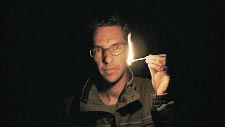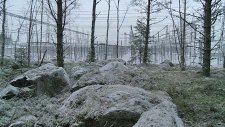
Into Eternity shines a light on storage of nuclear waste
"It has never been, in my perception, a real place," Michael Madsen says, speaking of Onkolo. Watching Into Eternity, you might understand what he means. Onkolo, or 'hiding place', is Finland's intended depository for the waste produced by nuclear power plants. It's a place where the focus is not on the present, but on the future - because once complete, Onkolo will remain dangerous for a hundred thousand years.
Peering forward into that future, what can we hope to see? Everything is imaginary. What might it be like for somebody in the future, uncovering Onkolo, looking back? "I saw this as a kind of science fiction documentary," Michael explains. "The camera is a visitor from the future, looking back at where we are now. The design concept for the film, as for Onkolo itself, evolved around the idea that at some point in the next 100,000 years our civilisation will probably cease to exist. Beyond that point where total oblivion has come, it's hard to know what will be important to people. We had this idea that the camera doesn't really know what's important to film. Perhaps it doesn't film people - it might be just as likely to focus on a colour or a shape. But this can help to provide us with a better perspective on our own time."
The idea for the documentary developed in the most mundane of ways, when Michael was doing his dishes, "trying to distract myself from this really boring work by listening to the radio." He heard a report about the business of nuclear waste storage, with the timespan involved, and "knew immediately that there was something very interesting in this. It's outside our own time and space, so it offers a unique vantage point."
There have been many different suggestions about what to do with nuclear waste. Most are really non-starters, as Into Eternity quickly makes clear. So we come to Onkolo. "This is the first time in our history that we have really had to deal with a problem and a responsibility of this magnitude," Michael observes. "I didn't understand ow to relate to that, but it was clear that people in Finland would have to find out what kind of scenarios might apply in the future. In 100,000 years it's likely that we humans will not be very much like we are today, and that the world will be experienced very differently. I talked to people at the company which was dealing with it. They quickly realised that what they were doing was more than just creating a final repository. It was something philosophical, something existential."

Unfortunately, making documentaries about the nuclear industry is not an easy thing to do. Michael explains that they are very wary because most of the coverage they get is negative. He was initially welcomed by the people he was filming with, but their relationship went on to deteriorate drastically as they realised that the film was actually going to happen and would one day be released. The Finnish Nuclear Authority, however, has said in retrospect that it thinks the film is very good.
Persuading those involved to cooperate wasn't the only problem Michael faced - he also had to film in some dangerous places. The tunnels of Onkolo itself only held the mundane risks associated with any building site, but the interim facilities were a different matter. "We had to wear protective gear and there were Geiger counters. Our radiation levels were measured when we left. For one shot we were in part of a building where nobody had been for years so they were very keen to dust us down and check our levels when we left, so they could find out about it. It was an eerie place to be because some of the pools of water there were very beautiful. I just wanted to jump in, but it's probably better not to!"
So does he think that people in that far future might one day see his film, and was this a consideration when making it?
"Yes," he says. "It was a serious consideration from the start. With the graphical design, we wanted to enable someone to watch and make sense of it without having any prior knowledge. But it's a difficult thing to do. It's like the message we sent out on a spaceship - two human figures waving to possible alien creatures, trying to communicate something about where our solar system is and what we know about atoms and that sort of thing, but will anybody be able to make sense of it? We have talked about leaving a copy of our film halfway down the tunnel in Onkolo, but of cause that would also require a DVD player and a television, so it's complicated."
Did it change him as a person, taking on such a big subject?
"I'm not sure if I've gotten any wiser about what 100,000 years really means," he says. "What really worked for me were the abstract elements. I think they helped me to connect, to experience it as more than just an intellectual number that you understand with your mind but that doesn't really mean anything."
And, in the shorter term, what does the future hold for him?
"I'm working on a new project with the same production company, Magic Hour. It asks questions about how we conduct civilisation, but I can't say more at this stage because it's in development and I think it will be controversial."
On the strength on Into Eternity, it seems likely that this is one project which will be worth waiting for.





















